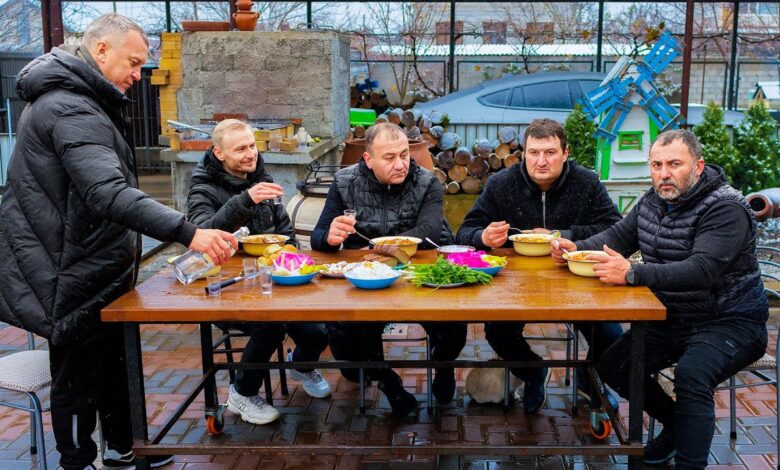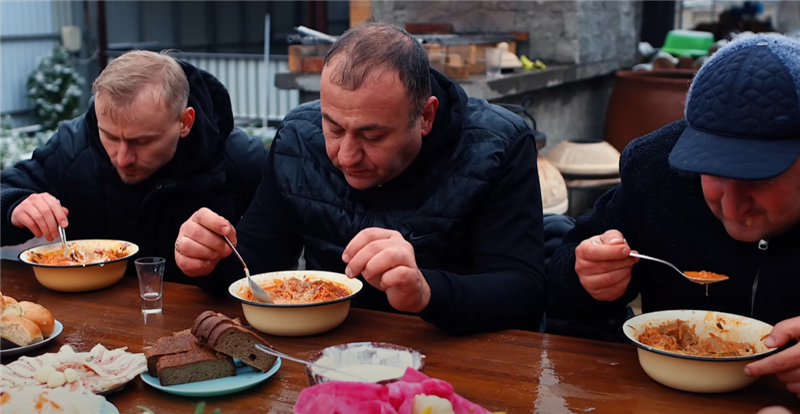You must try this borscht recipe – KAVKAZ

1. Introduction – What Makes This Borscht Special?
Borscht, the iconic Eastern European beet soup, is a vibrant and soul-warming dish. But Georgy Kavkaz’s version transforms it into something marvelous—infused with rich flavors and Georgian twists. He labels it “a borscht you’ve never tried,” and that promise is well-deserved. We’ll explore not just how to make it, but also why it stands out.
2. Historical and Cultural Context
- Origins of Borscht: Traditionally rooted in Ukrainian, Polish, and Russian cooking, borscht centers on humble beets, cabbage, and broth.
- Caucasus Influence: Hailing from Georgia, Kavkaz introduces dried fruits, unique spice mixes, and creamy finishes that bring sweetness and depth not always found in classic recipes.
This fusion between Slavic and Caucasian cuisine reflects centuries of cultural exchange across the region.
3. Ingredients Breakdown
Lists simple components—yet together they form a magnificent flavor profile. Here’s what you’ll need:
Vegetables & Produce
- Beets (2 large)
- Carrots (2 medium)
- Potatoes (3 medium)
- Onion (1 large)
- Garlic (3–4 cloves)
- Cabbage (half small head)
- Tomato paste or fresh tomatoes (2 tbsp or 1 fresh)
Protein & Umami
- Beef bones/meat (500 g)
- Optional smoked pork belly or ham hock
Fats & Dairy
- Vegetable oil (3 tbsp)
- Sour cream or full-fat yogurt for serving
Seasonings & Spices
- Salt & pepper to taste
- Bay leaves (2–3)
- Dried stone fruits (plums/apricots)—a Georgian touch
- Vinegar or lemon juice (1 tbsp)
- Greens (dill, parsley, chives)
These ingredients provide earthy, sweet, savory, tart, and creamy notes—a balance that defines striking borscht.
4. Step‑by‑Step Cooking Process
Let’s break it down, mirroring the flow of Kavkaz’s tutorial (with estimates where needed).
A. Preparing the Broth (1–1.5 hours total)
- Rinse and simmer beef bones with water in a large pot.
- Skim foam as it forms.
- Add salt, peppercorns, bay leaves—keep bubbling at medium heat for 45 minutes.
B. Vegetables: Prep & Sauté
- Peel, julienne, or grate beets and carrots separately.
- Chop onion finely. Cube potatoes; shred cabbage; mince garlic.
- In a skillet, heat oil over medium heat:
- Sauté onion until translucent.
- Add carrots, beets, and a splash of broth—cook ~10 minutes.
- Stir in tomato paste and vinegar; mix well and simmer to meld flavors.
This step caramelizes the veggies, enhancing sweetness and color.
C. Combining in the Soup Pot
- Strain the broth; return it to the pot.
- Add cubed potatoes; simmer 10 minutes.
- Spoon in sautéed veg mixture; stir carefully.
- Add cabbage and dried stone fruits. Cover and simmer until everything is tender (~15–20 min).
- Taste, adjust salt/pepper, add extra acid if needed.
D. Final Touches & Serving
- Turn off heat; add fresh chopped herbs.
- Ladle into bowls, top with sour cream.
- Serve with rye or black bread, garlic, horseradish, fresh onions.
5. Why It Works: Flavor & Texture Explained
- Sautéing Veggies: Deepens flavor and softens texture.
- Beet Caramelization: Adds sweetness and vibrant color.
- Dried Fruits: Georgian signature—adds gentle sweetness and complexity.
- Sour Cream: Adds fat and tang; helps mellow sweetness.
- Vinegar/Lemon Juice: Important for balancing sweetness and brightening the soup.
6. Variations & Personal Touches
Recipes are guidelines. Feel free to tailor:
- Meat Variations: Chicken/vegetable for lighter dish.
- Smoked Meat: Adds soul-deep smokiness.
- Vegetarian Version: Omit meat, use vegetable broth and mushrooms.
- Spicy Kick: Add chili flakes or ground paprika.
- Cream Alternative: Greek yogurt or crème fraîche.
7. Expert Tips & Troubleshooting
- Color Fix: Add baking soda to sauté pan to preserve beet color.
- Odd Sweetness: Add extra acid if it tastes too sweet.
- Broth Clarity: Strain before adding vegetables.
- Herbs Timing: Add fresh herbs and garlic at the end—heat them gently to preserve aroma.
8. Pairings & Presentation
Ideal with crusty bread, garlic or black bread, horseradish. Serve with pickled vegetables or a light salad to cut richness.
9. Health & Nutrition Overview
Borscht is nutrient-rich: beets for folate/K, carrots for A, lean meat for protein, and cabbage for fiber. Light versions reduce fat with low-fat yogurt.
10. Conclusion – A Feast for the Soul
Kavkaz’s version is more than soup—it’s a journey. It weaves flavors from share of Ukraine, Russia, and Georgia into something transcendent. Whether for cozy winter nights or festive gatherings, this borscht celebrates community, authenticity, and culinary craft.
Try it. Love it. Make it part of your tradition.










